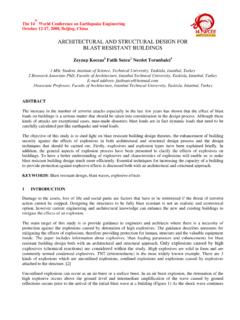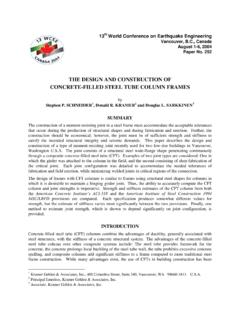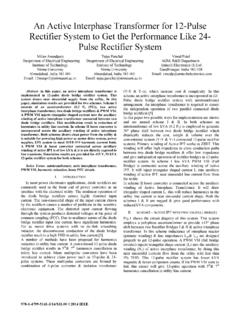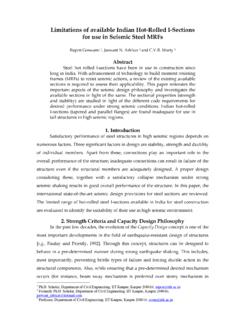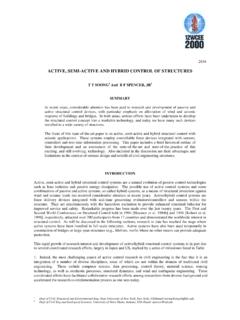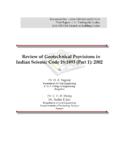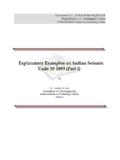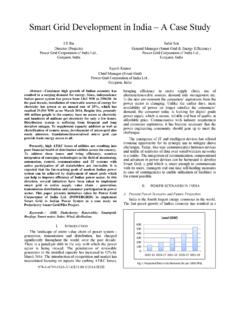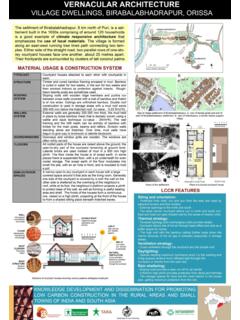Transcription of INDIGENOUS EARTHQUAKE-RESISTANT …
1 13th World Conference on earthquake Engineering Vancouver, , Canada August 1-6, 2004 Paper No. 5053 INDIGENOUS EARTHQUAKE-RESISTANT technologies AN overview Ravi SINHA,1 Svetlana BRZEV2 and Gayatri KHAREL3 SUMMARY INDIGENOUS EARTHQUAKE-RESISTANT housing technologies have developed in different parts of the world to enable the people to safely withstand earthquakes. These technologies also address other crucial factors such as availability of local construction materials, functionality of the building designs and safety of the occupants from weather extremes. Unfortunately, these technologies are becoming increasingly unpopular due to large-scale induction of modern construction materials and technologies . However, a large proportion of modern buildings in developing countries perform unsatisfactorily during earthquakes due to improper construction.
2 An evaluation of the INDIGENOUS EARTHQUAKE-RESISTANT technologies shows that they follow all the guiding principles of sound EARTHQUAKE-RESISTANT design and construction practices. Their lack of popularity stems mainly from the absence of modern engineering tools for their design and construction. This paper discusses the key features of the INDIGENOUS EARTHQUAKE-RESISTANT construction technologies and describes the conditions in which they are found ideally suitable for large-scale use in developing countries. INTRODUCTION Earthquakes and their disastrous consequences have been instrumental in shaping human history, and gaining knowledge to predict or prevent earthquakes disasters has been an integral part of human quest for knowledge since earliest times.
3 Available information shows that several ancient civilizations developed legends to rationalize earthquake disasters and to link their occurrence with deviant or undesirable human behavior. For example, the ancient Japanese believed that the earthquakes were caused due to wriggling of a giant catfish that kept the ground afloat. This catfish could be kept still only by god Kashima, which kept the catfish pinned except when the demons became strong enough to disturb Kashima. The human attempts to overcome the disastrous consequences of earthquakes have included: (1) spiritual efforts through prayers and appeasement of gods, (2) scientific efforts through identification of 1 Professor, Department of Civil Engineering, Indian Institute of Technology Bombay, India.
4 Email: 2 Instructor, Department of Civil & Structural Engineering, British Columbia Institute of Technology, Canada, Email: 3 Assistant Bridge Seismic Engineer, South Caroline Department of Transportation, USA. Email: earthquake -prone areas and prediction of earthquakes, and (3) engineering efforts through development of EARTHQUAKE-RESISTANT construction technologies . The scientific quest of predicting earthquakes still continues in modern times with only very limited success. However, several ancient civilizations were able to identify areas prone to repeated large earthquakes. The most remarkable achievement of ancient cultures and civilizations has been the development of several different INDIGENOUS EARTHQUAKE-RESISTANT construction technologies .
5 The effectiveness of these traditional technologies has been clearly brought out during recent earthquake disasters. For example, during the Bhuj earthquake in India in 2001, a large number of traditional constructions experience low level of damage while their neighboring modern buildings suffered extensive damage and loss of life. Similar experiences have also been repeated in the Marmara earthquakes in Turkey in 1999, the Killari earthquake in India in 1993 and several other recent earthquakes. These clearly show that the local traditional construction practice had adapted EARTHQUAKE-RESISTANT technologies , which are now being lost due to the induction of modern materials and construction techniques in these areas without addressing the seismic safety of modern constructions.
6 In traditional constructions, the architectural forms, choice of building materials and structural configurations have typically evolved from day-to-day living considerations. These were required to satisfy the needs of normal lifestyles and also adequately shield the occupants from extreme weather conditions (heat, cold, flooding etc.) and external threats. The weather extremes are an annual feature and their maximum can be effectively assessed based on the accumulated memory of a few generations. The development of housing technology addressing extreme weather conditions can therefore be based on the living memory of the people spanning two or three generations. The earthquake disasters, on the other hand, have long return periods (several years to several dozen decades) even in the highly earthquake -prone areas of the world.
7 The normal housing technology evolution process is therefore not expected to result in widespread incorporation of EARTHQUAKE-RESISTANT technologies , which cannot be based on living memory of a few generations, except through systematic collection and processing of knowledge spanning over several generations. The evolution of EARTHQUAKE-RESISTANT construction practice therefore demonstrates that an effective process for collecting and incorporating scientific knowledge existed in these cultures and civilizations. The modern construction practice in most countries is governed through standard codes and specifications. These standards specify and control all aspects of analysis, design and construction of structures.
8 Most standards are based on the knowledge of seismology and earthquake engineering and are able to incorporate advanced concepts and developments of these fields. The codes and standards in both developing and developed countries are similar in their specifications since they all use the same worldwide knowledge of construction materials and structural behavior. However, the performance of modern buildings in developed countries has been very different from those in developing countries for similar earthquake events. While most buildings in developed countries perform as per the specifications, the performance of similar buildings in developing countries where modern standards are in use have been found to be highly deficient.
9 The poor performance of building stock during earthquakes in several developing countries indicate that the basic problem of modern construction may not be in the technical adequacy of the standards but in their implementation and compliance systems. This also clearly illustrates the inability of the engineering profession to follow and enforce the modern standards. The traditional EARTHQUAKE-RESISTANT construction technologies are empirical and their specifications are based on thumb rules. As a result, the critical elements from earthquake -resistance considerations are not always understood by the practitioners of this trade. The empirical nature of these construction technologies has also inhibited their standardization, which is a prerequisite for all modern construction practices.
10 However, good performance of traditional EARTHQUAKE-RESISTANT constructions in regions where modern construction technologies have performed unsatisfactorily provide important lessons for seismic safety of the economically weaker sections of the society. It is generally found that the owners of buildings constructed with modern materials and technology in developing countries belong to the socially and economically more affluent classes. On the other hand, the economically weaker sections of the society are more likely to use traditional construction materials due to its lower cost. Since most INDIGENOUS EARTHQUAKE-RESISTANT construction technologies have relatively low cost, the use of these provide an exciting opportunity for safer housing for the economically weaker sections of society who are otherwise forced to live in weak constructions.
